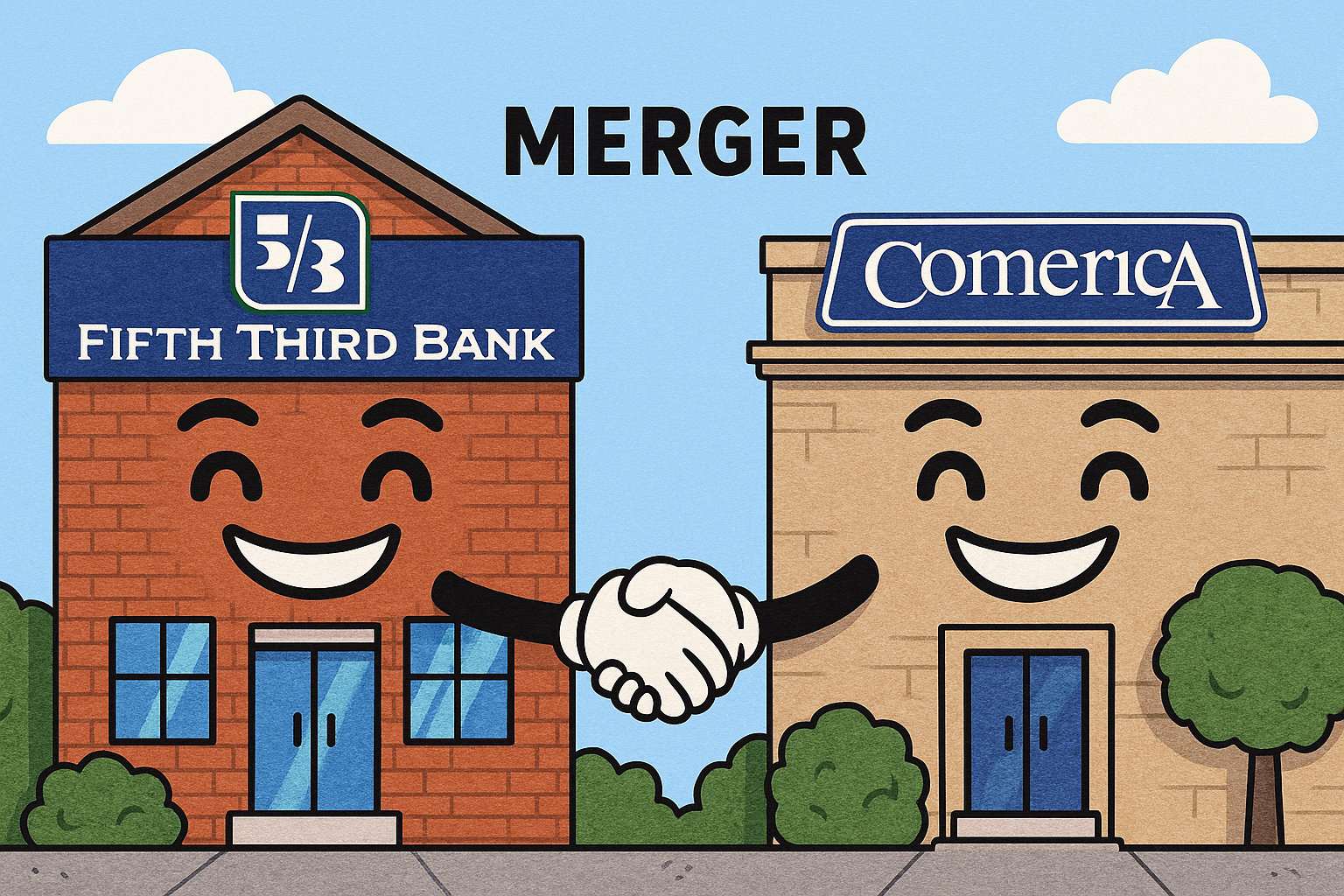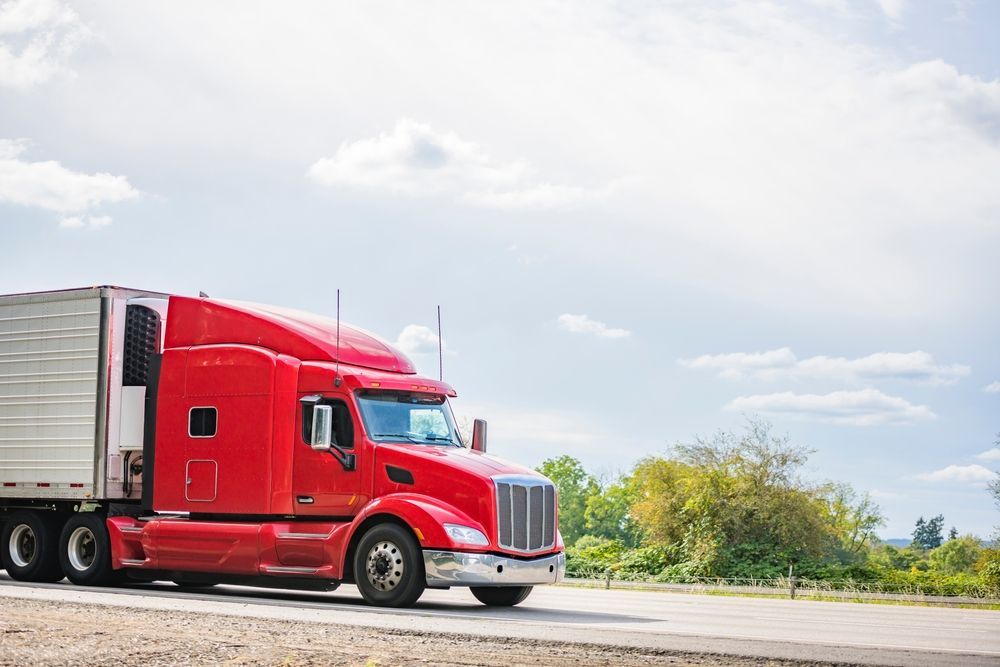Fifth Third’s $11B Comerica Deal: Impact on Trucking
Share this Article:

When Fifth Third Bancorp announced its $10.9 billion all-stock acquisition of Comerica Inc. in early October 2025, headlines naturally focused on the banking sector. The combined company will become the ninth-largest U.S. bank by assets — roughly $288 billion — extending Fifth Third’s Midwest roots deep into Texas, California, and the Southeast.
But for the trucking industry, the merger’s impact may be just as significant. As one of the nation’s most capital-intensive and credit-dependent sectors, trucking depends heavily on banks for fleet financing, equipment leasing, working capital, and treasury services. A merger of this size reshapes that landscape in ways that could both help and challenge carriers of every size.
1. The deal in brief
Under the terms announced October 6, 2025, Comerica shareholders will receive approximately 1.8663 shares of Fifth Third stock per Comerica share. Fifth Third shareholders will own about 73 percent of the combined company; Comerica shareholders about 27 percent. The deal is expected to close by Q1 2026, pending regulatory approval.
Executives from both banks described the transaction as a natural extension of complementary strengths: Fifth Third’s strong Midwest and Southeast presence with Comerica’s footprint in Texas and the West Coast. The combined bank gains scale in commercial lending, payments, and wealth management — areas central to corporate and middle-market clients, including trucking and logistics.
Both institutions already serve transportation companies. Fifth Third operates a Transportation vertical inside its Corporate & Investment Banking division, while Comerica has long-standing relationships with trucking, manufacturing, and dealer-finance clients.
2. The trucking industry’s banking reality
Trucking is capital-intensive, fragmented, and cyclical. Even large carriers operate on thin margins, and smaller fleets depend on local or regional banks for credit lines, factoring, and equipment loans.
At any given time, trucking companies need access to several financial tools:
- Fleet financing for tractors, trailers, and technology upgrades
- Lines of credit to smooth volatile cash flow
- Fuel and maintenance cards or treasury services to manage expenses
- Leasing programs to spread risk and manage fleet age
- Payments and receivables platforms for quick turnaround of customer invoices
The Fifth Third–Comerica merger could shift these dynamics by changing who provides capital, where decisions are made, and how credit risk is evaluated.
3. Greater credit capacity — but more centralization
On paper, the combined bank’s larger capital base could be a net positive for trucking. A stronger balance sheet allows the institution to take on bigger loans, reduce concentration limits, and expand industry verticals such as transportation.
That could translate into:
- Higher lending limits for large and mid-sized carriers that previously exceeded Comerica’s thresholds.
- Improved cost of funds, as a larger bank can borrow and lend more cheaply, potentially lowering loan interest rates or leasing costs.
- Integrated service packages combining loans, treasury, and payments — especially appealing to large regional carriers.
However, bigger banks often bring centralized credit decisions and more rigid underwriting.
What once might have been a relationship-based loan from a Comerica regional manager could now require approval through Fifth Third’s national credit committee. Owner-operators and small carriers may lose the personal relationships that previously enabled flexible terms or quick funding decisions.
In the short term, as integration progresses, credit pipelines could even slow — mergers often lead to temporary “pause periods” in loan approvals as systems, risk models, and teams are unified.
4. Implications for fleet financing and leasing
Comerica and Fifth Third both maintain equipment-finance divisions that support trucking fleets. Their merger creates one of the larger U.S. regional bank leasing portfolios.
Potential benefits:
- More competitive leasing rates as the combined entity can fund longer-term or larger-volume transactions.
- Broader geographic reach, giving carriers in Texas, the Southeast, and the Midwest access to similar products and terms.
- Cross-selling opportunities — for example, linking lease structures with fuel or payments accounts for operational efficiency.
Potential drawbacks:
- Stricter asset-residual policies. Fifth Third may impose uniform rules that raise down payments or limit balloon-payment structures.
- Reduced flexibility for smaller fleets seeking nonstandard lease terms.
- Risk re-rating if the merged bank decides to treat trucking as a “high-volatility commercial sector.”
Fleet operators should watch closely for early communications from Fifth Third’s transportation-finance team. Locking in current rates or extending existing lines before the merger closes could prove prudent.
5. Working capital and cash-flow management
Trucking’s profitability depends on managing cash-flow timing — expenses like fuel, driver pay, insurance, and maintenance occur daily, while shippers often pay 30–60 days after delivery.
Both Fifth Third and Comerica offer factoring, invoice financing, and supply-chain payment tools. The combined entity will likely try to scale these, possibly offering:
- Faster invoice funding through integrated digital platforms
- Unified cash-management portals with real-time visibility of accounts and payments
- Expanded fuel-card and treasury-management programs tailored to transport
For large carriers with sophisticated treasury departments, this could be a win: a one-stop bank with national coverage and strong digital tools.
For smaller fleets, however, consolidation could reduce competition and bargaining power. Regional or community banks that once priced aggressively to win transport business may struggle to compete, pushing carriers toward larger institutions that may charge higher fees.
6. Effects on interest rates and cost of capital
The merger itself does not directly change national interest rates, but larger institutions face higher regulatory capital requirements. If Fifth Third must hold more Tier 1 capital post-merger, it may price loans slightly higher to maintain returns.
For trucking companies, even a 25- to 50-basis-point rate increase can meaningfully impact operating margins, especially on fleet loans exceeding several million dollars.
That said, a stronger, better-capitalized bank could offer more stable financing through economic downturns — an advantage when freight cycles soften and smaller banks retreat from riskier lending.
7. Geographic shifts and regional access
Geography matters in trucking finance. Comerica’s strength in Texas and California complements Fifth Third’s Midwest and Southeast dominance. The merged bank will have branches and corporate offices in nearly every major freight corridor — from Chicago to Dallas to Atlanta and Los Angeles.
This could mean:
- Improved access for carriers headquartered in Sunbelt and Southeast states, where Fifth Third gains new presence.
- Potential branch closures in overlapping Midwest markets, which might reduce local access for smaller carriers.
- Centralized decision-making in Cincinnati or Dallas, potentially slowing loan approval for independent operators accustomed to local bankers.
Carriers should monitor which offices remain designated for transportation lending and whether local relationships will continue post-integration.
8. Technology and payments modernization
A major motivation behind the deal is to scale digital payments and commercial treasury services. Fifth Third has invested heavily in fintech integration, real-time payments, and automated receivables platforms. Comerica’s small-business and commercial clients could benefit from these upgrades.
For trucking companies, this modernization could:
- Enable instant driver reimbursements or fuel-card settlements
- Simplify freight-broker payments through faster ACH and RTP networks
- Improve visibility into daily cash balances for fleet managers
The challenge will be integration speed. During the merger transition, systems migrations sometimes cause delays or compatibility issues — something that can disrupt payment cycles for fleets relying on precise timing.
9. Competitive banking landscape for trucking
The Fifth Third–Comerica deal is part of a broader consolidation trend among U.S. regionals. As mid-tier banks combine, the number of relationship-oriented lenders serving transportation shrinks.
Consequences for trucking:
- Less competition in mid-market fleet lending could push borrowing costs up.
- Increased emphasis on large clients — the merged bank may favor carriers with $50 million+ annual revenue over small operators.
- Greater need for specialized lenders — trucking companies may turn to nonbank financiers, private credit funds, or OEM-linked finance arms for flexibility.
At the same time, a more robust regional bank could rival Wall Street lenders in offering integrated solutions — credit, treasury, payments, and advisory — under one roof.
10. Risk management, ESG, and compliance pressures
As the merged bank moves into the top-ten U.S. banks, it will face stricter regulatory oversight and greater public scrutiny, including ESG (environmental, social, and governance) expectations.
That could flow down to trucking clients through:
- ESG-linked lending criteria, where interest margins depend on emissions reductions or fleet efficiency metrics.
- Enhanced compliance documentation for credit renewals and equipment loans.
- Pressure to modernize fleets, favoring electric or low-emission vehicles to align with the bank’s sustainability policies.
Forward-thinking carriers could benefit by positioning themselves as “green fleet” partners eligible for sustainability-linked financing programs.
11. Short-term turbulence, long-term potential
Bank mergers often bring short-term disruption — system conversions, staffing changes, repricing of portfolios, and delays in approvals. Trucking firms should expect some administrative turbulence through late 2025 and early 2026.
However, the long-term outlook may be positive: a financially stronger, geographically broader, technology-driven bank could become a reliable partner for the trucking industry’s next growth phase — particularly as freight volumes rebound and fleet electrification accelerates.
12. Practical steps for carriers and logistics operators
To prepare for the coming changes, trucking leaders should act now:
- Review current credit lines and leases.
Confirm renewal dates and consider extending them before merger-related repricing. - Diversify banking relationships.
Maintain at least one backup relationship with another regional or national bank to preserve bargaining leverage. - Engage relationship managers early.
Ask how your accounts will transition and which teams will handle transportation finance post-merger. - Lock in fixed-rate loans while rates remain stable and before potential spreads widen after integration.
- Leverage technology improvements.
Prepare to adopt Fifth Third’s advanced payments platforms once integration completes — faster settlements can improve cash flow. - Highlight sustainability initiatives.
Demonstrate how fleet modernization aligns with the bank’s ESG lending preferences to improve financing terms. - Monitor local footprint changes.
Stay alert to branch consolidations or decision-center moves that could affect access to credit officers.
13. Outlook: Fewer banks, bigger consequences
Trucking operates on narrow margins and heavy debt. As the number of independent regional banks declines, access to relationship-driven lending — once a hallmark of the industry — becomes rarer.
The Fifth Third–Comerica merger exemplifies this consolidation wave. Whether it ultimately helps or hinders the trucking community will depend on execution:
- If the merged bank invests in transportation expertise and regional presence, carriers could see stronger partners with deeper pockets.
- If it centralizes decision-making and tightens risk policies, smaller fleets could find credit harder to obtain.
Either way, the merger underscores a new reality: financial partnerships now carry strategic weight equal to fuel, drivers, or freight contracts. Trucking executives must treat banking strategy as part of their operational playbook.
Conclusion
The $11 billion Fifth Third–Comerica deal is more than a banking headline — it’s a turning point for how capital flows through the trucking ecosystem. In the near term, carriers should expect integration bumps, shifting contacts, and possible repricing. But in the long run, a stronger, digitally advanced, and nationally diversified bank could bring stability, innovation, and scale to trucking finance.
Still, success will hinge on one thing: whether the merged bank keeps trucking relationships personal and accessible, or lets consolidation turn into distance. For an industry that runs on relationships and reliability, that distinction will make all the difference.
Share with Us:




